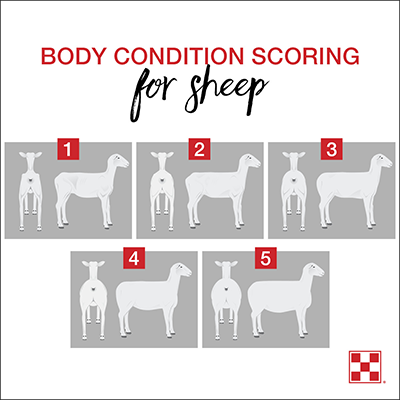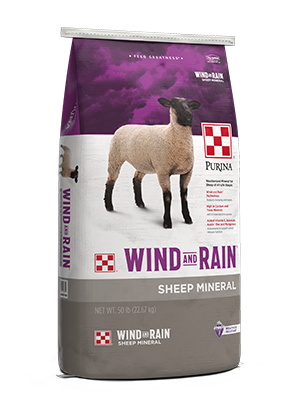
Help Ewes Bounce Back After Lambing Season
Wellness : Health
Wellness : Nutrition

Getting ewes up and going faster after lambing can help minimize body condition loss, help keep ewes and lambs in good health throughout lactation and keep you on track for next breeding season.
A few simple, proactive steps can help ewes bounce back quickly after lambing season:Start with sheep body condition score
Post-lambing recovery starts by supporting body condition pre-lambing. Ewes in proper body condition going into lambing season will have the reserves they need to bounce back quicker post-lambing and recover lost condition.
Target a sheep body condition score (BCS) of 3-3.5 going into lambing season and use this chart to monitor your flock’s condition throughout gestation.
Add free-choice access to Purina® Accuration® Sheep & Goat Hi-Fat Block during the third trimester to help maintain body condition. Fat has double the amount of energy when compared to a carbohydrate source such as corn, making it an efficient energy source to keep ewes in condition.
The most common lambing problems are:
Mineral nutrition can go a long way to help address these challenges. Provide a free-choice sheep mineral high in calcium in the third trimester at a minimum (ideally year-round) to help maintain optimal health.
Parasites are another common concern immediately after lambing that can drain ewes’ energy and fat reserves. After lambing, administer a dewormer to head off any health issues.
If BCS drops too low during lactation, you could face increased nutrition expenses to get them back into shape in the lead-up to breeding. And, you could have challenges rebreeding, resulting in a late lambing season the following year.
Provide supplements high in fat and protein post-lambing and during lactation to recover and maintain body condition score. Free-choice sheep mineral and a high-quality forage are also recommended.
If it’s not feasible to supplement all ewes throughout lactation, focus on high-risk animals –yearlings and low BCS animals.
If ewes aren’t getting enough protein or energy, you could see decreased milk production, resulting in lambs not growing as rapidly as they should. And, you could see a higher death loss percentage in young lambs because mom isn’t milking adequately.
Look for a high-fat supplement to support milk production. An added benefit: Increasing fat in ewes’ diets will increase milk fat levels, helping lambs grow and bloom more rapidly.
A faster return to normal after lambing season is possible and will make next breeding season much smoother. Learn more about how you can prepare ewes for a successful breeding season.
A few simple, proactive steps can help ewes bounce back quickly after lambing season:
Start with sheep body condition score
Post-lambing recovery starts by supporting body condition pre-lambing. Ewes in proper body condition going into lambing season will have the reserves they need to bounce back quicker post-lambing and recover lost condition.Target a sheep body condition score (BCS) of 3-3.5 going into lambing season and use this chart to monitor your flock’s condition throughout gestation.
Add free-choice access to Purina® Accuration® Sheep & Goat Hi-Fat Block during the third trimester to help maintain body condition. Fat has double the amount of energy when compared to a carbohydrate source such as corn, making it an efficient energy source to keep ewes in condition.
Dystocia and other lambing problems
Ewes will take longer to get back on feed, recover and provide nutrition to newborn lambs if they experience health challenges during lambing.The most common lambing problems are:
- Dystocia: Difficult or obstructed labor
- Hypocalcemia: Reduced calcium levels during late gestation
- Cervical dilation challenges: When lambs are in the birth canal, but the cervix doesn’t dilate
- Ketosis (or pregnancy toxemia in sheep): A lack of fat in the diet, resulting in ewes pulling from their body tissue for energy
Mineral nutrition can go a long way to help address these challenges. Provide a free-choice sheep mineral high in calcium in the third trimester at a minimum (ideally year-round) to help maintain optimal health.
Parasites are another common concern immediately after lambing that can drain ewes’ energy and fat reserves. After lambing, administer a dewormer to head off any health issues.
Maintain BCS during lactation
Ewes will drop condition due to lambing stress and lactation energy requirements. The key is to minimize the amount of condition lost and get ewes back to the target BCS as soon as possible. Ideally, ewes should be a 2.5 BCS through lactation to hit a 2.5-3 BCS during breeding season.If BCS drops too low during lactation, you could face increased nutrition expenses to get them back into shape in the lead-up to breeding. And, you could have challenges rebreeding, resulting in a late lambing season the following year.
Provide supplements high in fat and protein post-lambing and during lactation to recover and maintain body condition score. Free-choice sheep mineral and a high-quality forage are also recommended.
If it’s not feasible to supplement all ewes throughout lactation, focus on high-risk animals –yearlings and low BCS animals.
Support ewes, support lambs
In addition to maintaining BCS, supplemental ewe nutrition during lactation provides many benefits to newborn lambs.If ewes aren’t getting enough protein or energy, you could see decreased milk production, resulting in lambs not growing as rapidly as they should. And, you could see a higher death loss percentage in young lambs because mom isn’t milking adequately.
Look for a high-fat supplement to support milk production. An added benefit: Increasing fat in ewes’ diets will increase milk fat levels, helping lambs grow and bloom more rapidly.
A faster return to normal after lambing season is possible and will make next breeding season much smoother. Learn more about how you can prepare ewes for a successful breeding season.


.png?width=300&height=430&ext=.png)
